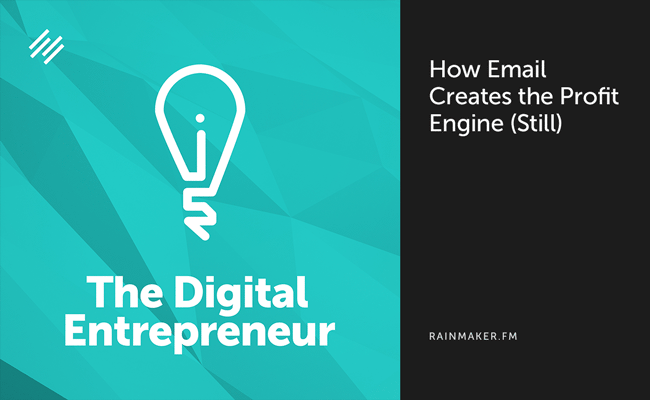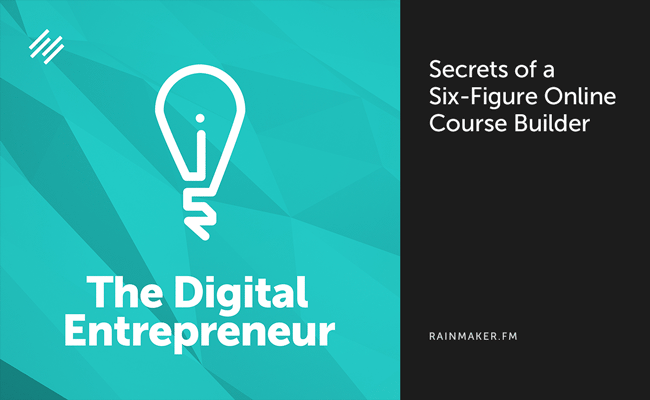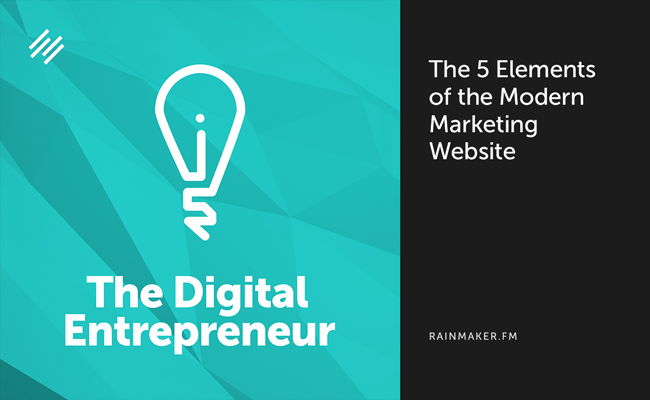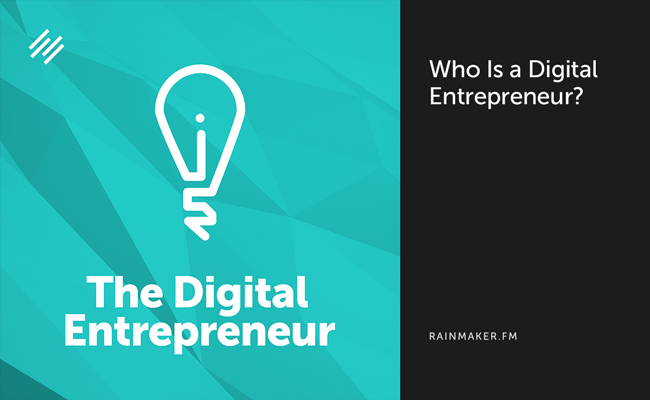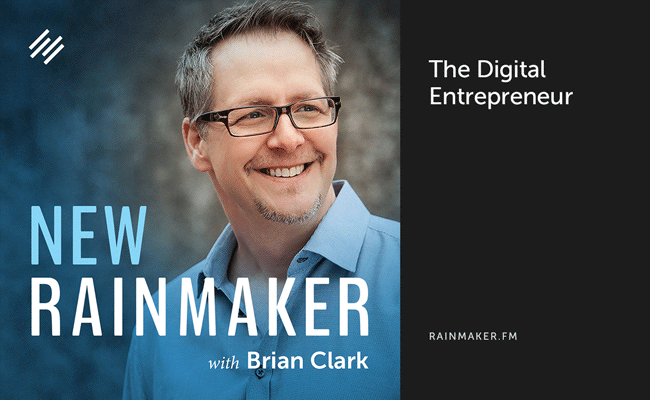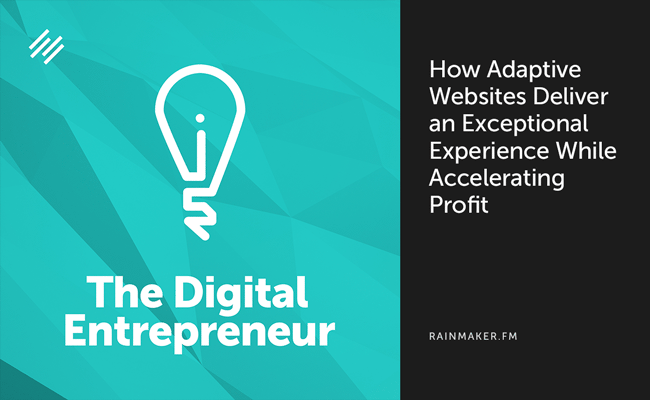
When your website delivers the right piece of content at the right time to the right person — and in the right format — you create experiences that pull people in and increase your chances of compelling registrations and driving sales.
In this 33-minute episode, Brian Clark and Jerod Morris discuss:
- Why responsive design is the bare minimum
- How every buyer journey is unique (yet we often treat it as the same)
- The three aspects of journey mapping
- How you start the process with a free course
- How you accelerate the profit engine with perpetual promotion
Listen to The Digital Entrepreneur below …
The Show Notes
The Transcript
How Adaptive Websites Deliver an Exceptional Experience While Accelerating Profit
Voiceover: You’re listening to The Digital Entrepreneur, the show for folks who want to discover smarter ways to create and sell profitable digital goods and services. This podcast is a production of Digital Commerce Institute, the place to be for digital entrepreneurs.
DCI features an in-depth, ongoing instructional academy, plus a live education and networking summit where entrepreneurs from across the globe meet in person. For more information, go to DigitalCommerce.com.
Jerod Morris: Welcome back to The Digital Entrepreneur, everybody. I am Jerod Morris, the VP of marketing for Rainmaker Digital, and I am joined on this episode by Rainmaker Digital founder and CEO Brian Clark. Brian, welcome.
Brian Clark: Thank you, Jerod. It’s always a pleasure to talk to you, which we do every day, day in and day out, but sometimes we record it.
Jerod Morris: That’s right. I feel like we should have been recording for the last half hour.
Brian Clark: Could have been good. Could have been bad. Who knows.
Jerod Morris: Yeah. Last week on The Digital Entrepreneur we talked about email and were going through the five elements of the modern marketing website. In today’s episode, we’re going to hit the second one. We’re going to talk about adaptive content and how websites that can adapt their content are able to deliver an exceptional experience for an audience while also having a big impact on revenue and on profit as well.
‘Adaptive Content’ Defined
Jerod Morris: It’s probably useful to begin just by making sure everyone is on the same page with ‘adaptive content,’ what the term means, what it is. I think most people are, but just to be sure. It is the right piece of content at the right time for the right person.
One thing that you and I have discussed and debated a little bit is where the idea of responsive design fits into this idea of adaptive content. Obviously, there are differing opinions on this. When we talk about adaptive content, where do you see responsive design fitting into it?
Why Responsive Design Is the Bare Minimum
Brian Clark: So we led with email because email is still the transaction engine, the profit engine, for online marketing–specifically for digital entrepreneurs, but also across the board. Then, now, we’re coming to, what are you doing with email? What is its function?
When we talk about adaptive content, people may think, in one way, that we’re using that terminology, but you and I had a discussion where I was originally separating responsive design from other forms of serving up the right content at the right time. Ultimately, you had the better way of thinking about it, but maybe it helps to talk about an adaptive website.
What is a website, really? It’s delivering up information that people want. The adaptive aspect of it is those people need to get that information when, where, and how they want it. ‘Responsive design,’ in case anyone is not familiar with the term, means that the design–the layout of your site, of a page, of a post, whatever the case may be–adapts to the device that it is being viewed with.
The example that I always like here’s a great one because it was so ironic. I was invited to be on a radio show that’s about online marketing. I originally got the invitation on my phone, by email, clicked on the link, and it’s a disaster. I can’t read anything. Everyone has experienced this.
Everyone out there is probably using your smartphone. You’ve gone to a site, and it’s either a disaster or the print is just so tiny you have to use your fingers to stretch out a little bit of one area so you can read that part. That’s a lot of work. It has to be the beginning with the design, the wrapper, that your pages, posts, and other content is wrapped in.
If people can’t even show up for the first time on the device of their choice and have that site design, that website be smart enough to know, “Oh, you’re on an iPad,” “Oh, you’re on an Android phone,” and then adapt itself accordingly so that that content can be consumed, that desire, that intent that person had when they clicked–whether it be in search, social, email, whatever the case may be.
So you’re right. It really is the beginning of what we’re talking about with adaptive websites or adaptive content. Often, you don’t get past the first step if your design is not responsive.
Jerod Morris: Right. Again, this bare minimum, it ensures that whoever comes to your website will get it in a format that they can consume. If it was the same person coming to your website every single time or the same type of person with the same needs, you could have the same content for every person–but we know that’s not true.
There are different people, different buyers, different personas, that come to your website that need to be taken on a different journey–if you want to truly engage them. The issue, though, and where this idea of adaptive content on an adaptive website comes into play, is that too many folks make the mistake of treating everybody the same when we know that the buyer journey–every buyer journey-is unique.
How Every Buyer Journey Is Unique (Yet We Often Treat It As the Same)
Brian Clark: That’s absolutely the truth, and you broke it down into different personas. But we know from usability data and observation that even similar personas will take different steps on the pathway. It’s not even uniform in that way, so we often talk about personas, archetypes, or avatars in order to craft the right words–yet we’re still eliminating behavioral dynamics from the whole equation.
We have the technology to do this, and that’s why we are stressing that what looks cutting edge now is just going to flat-out be the norm. This is a huge shift in websites. Just like I’m telling you, responsive design is the bare minimum, and we still have people who aren’t doing that.
I’m saying that your competition who is employing these principles is going to kick your butt. I’m sorry. There’s no other way to put it. The experience will be so personalized, and this isn’t a treat. It shouldn’t be a treat. As you said, every buyer’s journey is unique, yet historically, and a lot of people presently, are treating it like it’s all the same path.
Jerod Morris: I think most people get that idea, and of course, an idea is nothing without the execution of it. That’s where actually being able to go in, map these journeys, start to plot it out, and put it together with content becomes so important. Let’s talk about some different aspects of journey mapping, the first one being conditional pathways.
The Three Aspects of Journey Mapping
Brian Clark: Yeah. Just to back up a second there, there is a discipline called ‘customer experience mapping,’ which really maps things from problem and desire, to prospect, to customer, to repeat customer or recurring customer, all of these things. It’s a broad discipline, but at the very base level what you’re trying to do is strategically map out the steps that are involved–as opposed to one linear step-by-step progression.
For example, marketing automation, old school, is just an autoresponder. We’d set up a sequence. People enter it. They all get the same message. It converts at X. But it does not take into account behavior whatsoever, and that’s fine. But it’s no longer going to be even minimally acceptable as far as what we’re doing.
There are really three aspects when we’re talking about adaptive content from a journey-mapping standpoint. Like you said, the first one is conditional pathways. You have a sequence of messages, links to content, or whatever the case may be with the hopes that, at the point when you make an offer, more people than not are going to accept it.
Yet like I said, the path is not linear. What do you do if you get someone involved in some sort of access opt-in that we’ve talked about–and we’ll talk about in more detail in the next episode–yet you find that only 50 percent of those people take the first step?
That’s a different journey right there for half of your people, yet you’re treating them as if they’re all on the same path. Well, the people who didn’t do anything at first are on a different path. That’s a different conditional dynamic that you need to think, “Okay, what kind of message does this person need?” We’ll talk in more detail with an example in a little bit, but you get what I’m saying here, right?
There’s not one path. There’s all sorts of paths that they can go by and still become your customer, yet you have to address okay, this is a good time for one of our favorite metaphors: the content marketer as mentor. They’re on a journey. They’re the hero. We’re the mentor. We’re the guide–and this, yes indeed, ties right back to the more mythical hero’s journey.
You’re not being a good guide if you give everyone the same directions even though some people are off in the woods. There’s a condition where you need to go hunt them down, pull them out by the hand with the right message, the right content, whatever the case may be, and bring them back in line with the destination you’re trying to get them to.
Jerod Morris: Right, so it meets what they need at that time. You can’t do that if you’re just giving the same thing to everybody. To get this right requires the leg work of just sitting down at a desk and charting out, “The person goes here. They make Choice A. They make Choice B. You’ve got a fork in the road, and they’re going in different directions now,” and then creating content that will meet them at the step where they need it.
Brian Clark: Yeah. It really is a choose-your-own-adventure-type exercise. It can feel a little daunting until you get into it. Then it’s cool, really cool, because you get really excited about the experience you’re able to create for people.
So first of all, you have to understand that there are conditional pathways. Then you have to do what we’ll call ‘dynamic mentoring,’ which is what I mentioned as far as steering them in the right way based on their actual behavior. Where do you get the ammunition to do this strategic exercise? Well, it’s good old-fashioned research. The thing we harp on over and over again.
Know your audience. Know your prospect better than they know themselves. You have access to a whole diverse group of people who go on these journeys. You probably do know them a little better than they know themselves–which some people can find spooky–but if you’re enhancing their journey, you’re enhancing their experience to help them meet their objectives. That also helps you meet your business objectives. That’s a win-win.
That’s the spirit in which we need to think about these elements because the third aspect of journey mapping is just recognizing that these are individuals, and this is an individual experience. Just about every one of them should be unique in the sense that the way they actually behave dictated the experience. Things worked out just like they needed them to based on reality and not your ‘funnel sequence’–which is some sort of static pathway that doesn’t exist as reality in any place other than in an optimistic marketer’s mind.
Putting the Pieces Together and Doing the Work
Jerod Morris: The other thing to keep in mind, too–because you mentioned this whole process can sound a little bit daunting, and it’s not like we want to sugarcoat it and say that it’s not–it’s going to require work. You’ve got to really get in there, do the research, do the work.
But the thing you find–and that I’m finding, certainly, doing it–is that, if you’ve been serving this audience for a while, then a lot of times–when we talk about this fork in the road where the person can either accept your offer or they don’t–the reason why they don’t accept your offer, you may have content already in your archive that you can use. That may be what that person needs right now. Them not taking that offer almost identifies, “Okay, which content that I’ve already created can I now get to this person?”
It’s not like each of these decision points and each of these moments where the content needs to adapt you have to create something new. You may have done a lot of that work. Now, it’s just putting together the pieces of this journey and figuring out what goes where. You’ll have to create some new stuff, but a lot of it you may already have.
Brian Clark: Oh, absolutely. Without a doubt. The interesting thing that you mentioned there is directly on point–if someone’s not engaging, you either re-engage or you lose them. You don’t just plow through to your offer with a disengaged prospect. That makes no sense whatsoever. Not only does it kill your conversion rate, it annoys the person.
Why not send them on a path of realizing that they need a little bit more know, like, and trust? We talk about that all the time, but being able to actually know based on their behavior what their temperature is with our concentric circles that go from cold to warm to hot–literally, taking that person’s temperature based on their behavior and then warming them appropriately instead of just saying, “Ah, you’re all getting the same offer,” hammer-over-the-head-type situation.
Jerod Morris: Yeah, so let’s run through a few examples of this, then. Let’s talk about how this works in practice.
How You Start the Process with a Free Course
Brian Clark: Yeah. The variables and the possibilities are as only limited by your own creativity and your knowledge of your audience, as you said. Now, the great thing about this is, the technology is not the hard part.
To do this stuff in the past was very, very, very expensive, and most marketing automation software is still at the enterprise level, costing thousands and thousands of dollars a month. That’s a big problem that we’re trying to solve with the Rainmaker Platform–same power, less hassle, way less expense–so don’t let that part of it intimidate you.
Here’s a very, very simple scenario that I know you’ll appreciate. We’re going to talk later in this series about why free courses are the best access-type opt-in or registration generator. Briefly, that’s because it gives you a very systematic and strategic way to concisely educate people into what they need to know to make their first purchase with you. Now, of course, it could be a subsequent purchase, too, but let’s use that scenario.
Person is a prospect. They’re qualified, but they’ve never done business with you before. You put them in your sequence–and, of course, with Rainmaker, you can drip out lessons with the LMS, tie that to email to make this a very carefully spaced out and delivered course–but what happens if they don’t take the first lesson? You’ll be able to see that.
What if they don’t take the second lesson? Should you just go ahead and plow through and keep delivering lessons and then make an offer? No, because you can tell that person went off path. They did not receive the education that they need to do business with you, yet you’re treating them like you did.
If you know that someone didn’t take the first lesson–again, you’re on a different conditional pathway–you need to bring them back, if at all possible, to actually experience that course. They asked for it. They registered for it, but things happen. Life happens.
So that’s just a very simple way of, instead of delivering lesson two when they haven’t watched lesson one, sending them a message that prompts them gently to take lesson one. You can do that however many times you strategically develop is necessary in order to get them back on the path.
Again, there are much more complex and creative variations of this, but just think about it from that very simple scenario. You understand your audience. You know they need to know A, B, C, and D, and then they’re likely to buy. But they don’t even get started, or they leave out a middle lesson or something. Stop. Quit forcing them on lessons that don’t make any sense because they didn’t do the first one.
Jerod Morris: That’s why pulling it out of online where it’s so easy to feel like, “Okay, we’re sending this email out to this group of 1,000 people,” instead of thinking, “We’re sending it out to 1,000 individuals.” When you think about it in that sense and when you think about yourself as the mentor for 1,000 different people instead of just the mentor for this big group where you’re trying to herd a group, you’re trying to bring individuals through the journey.
If someone doesn’t get the information they need to take the next step with you, like you said before, you’re not going to just yank them through and keep force-feeding them stuff they’re not ready for. Really thinking about your audience in terms of individuals and adapting this experience for individuals, but doing it in an automated way so that it’s scalable is so important and, really, is kind of a subtle mindset shift people need to make to be successful with this.
Brian Clark: Yeah, the individual experience is the whole thing. That’s how you bring people back in line with again, they expressed an intent to learn something or to solve a problem. It’s your job as the dynamic mentor to do your best to get as many of those people in that position. Maybe they don’t all buy from you, but that’s the process by which more people do.
Jerod Morris: Yeah. Did you have another example that you wanted to cover in this episode, or save for next week when we talk about the access experience?
How You Accelerate the Profit Engine with Perpetual Promotion
Brian Clark: Yeah, this is some stuff that we’re working on ourselves, and it’s very fascinating. Again, remember the whole choose-your-own adventure. Well, they always choose their own adventure. It’s whether or not you’re staying in the adventure, or they’re going off to someone else.
But think about it. Let’s say, going back to the free course example, we have our conditional pathways, the dynamic mentoring messages that get more people where they want to go. Really, it’s not even back in line because there is no line. It’s the path that they’re going to follow.
Let’s say you’ve mapped that out, and it’s working more. You’re retaining and engaging more people, and they are educated to a point when you can do business with them. At that point, we generally will make an offer, but what do you know is the number one rule of promotions, Jerod, that they have to begin and they have to end, or people do not take action, correct?
Jerod Morris: Right, exactly.
Brian Clark: You’ve seen this. You’ve seen it upfront, live and center, for years now.
Jerod Morris: Yeah. You’ve got to have urgency and scarcity.
Brian Clark: Yeah, but it’s got to be real. The quickest way to ruin your reputation is to use fake scarcity and gimmicky timers and countdowns when it’s not real. There have been creative technological solutions with cookies and whatnot, but if you’re lying, people are going to stumble upon that. It’s just not going to do well for you, so we never fake scarcity.
If we say it’s ending at 5:00 on Friday, which we often do, then that’s when it ends, but that’s old thinking in the sense that you’ve got to send that promo basically to your entire audience to get the impact that you want. You can’t just necessarily do that every month.
You could automate the promotion so that when people come to you, they’ve gone through the steps you think are necessary to educate them, and it’s time to make an offer, why not say, “Hey, we’re about to do a special promotion on this product”? It could be a gateway product, or it could be your main thing, depending on your upsell strategy.
You get someone to click on that and say, “Yes, I am interested in seeing what this promotion is.” You’re not making the offer yet. You’re actually building a launch list, a mini launch list, but remember that this is automated. When you do a typical product launch, Jeff Walker calls it a two-week ‘sideways sales letter,’ and we’ve taken that and know that content marketing itself is a perpetual sideways sales letter.
You get people to get on board, take the offer at various times, but when you think about it and this is, of course, the conventional wisdom in content marketing. That is, you show up every day with a new angle on the topic hoping to connect and resonate. Well, that can work, but what would work better without creating all that content where you get people into a certain funnel and you educate them?
Again, you know your prospect. You know your audience. You’re giving them great value, great education, but why not be able to do a promo as part of that funnel that truly does expire in five days like we typically do with our hands-on promotions? Then the technology truly makes it stop. It truly is taken away. Now, we take away things manually. There’s no difference, though, so you can create this perpetual promotion cycle.
Let’s say you’re using Facebook Ads. You’ve got your targeting down, you’ve got your ads optimized, and you’re getting a great opt-in conversion rate for your money. Then once they get into the funnel, you’re able to sell them, make that offer–at the appropriate time–but you’re able to add the incentive of a promotion that is not publicly advertised. It’s not the normal pricing.
It doesn’t even have to be priced. It could be a bundle. It could be some other hybrid offer that provides more value than the traditional out-there model. But we know that if you just leave it out there forever, you’re not going to convert as many–and why would you? Why would you leave an offer out there that is substantially better than your normal offer and just leave it out there?
It can’t, but in order to do that manually, you would be constantly overwhelmed by trying to manage the process of where are they in the funnel, this, that, and the other.
This allows you to automate the entire progress, the entire journey, culminate with a true scarce offer, and have it end if they don’t act, so you’re telling the truth. But you’re creating a very dynamic, testable, and scalable, as you mentioned, funnel to where it just runs–no matter when they start.
Here’s an example of what this type of adaptive content can do. Someone clicks on that link–this is just an example–that says, “Yes, I’m interested in hearing about this promotion.” Then the day they do that sets a trigger that says two days later the offer is presented. Then there’s another trigger that hits then that kills that offer in four days.
All the dates are dynamically inserted, and the offer ends automatically at the time you’ve designated. You can see the power we’re talking about here, and these two examples are really just scratching the surface.
Putting It All Together: A Scalable System to Grow Your Business
Jerod Morris: Yeah. In summary, you use the concepts of adaptive content and responsive design to create an adaptive website. Then you go in and use the journey mapping that you talked about–with conditional pathways, dynamic mentoring, creating this individual experience–to create an exceptional experience for the individuals who are engaging with you. Then you use this idea of perpetual promotion to accelerate profit.
The combination of those three really creates this scalable system, machine, whatever you want to call it, that not only gives people an exceptional experience when they engage with you, but gives you something exceptional, too. You’re making offers to people at the right time when they’re going to be more likely to take them–which is how you grow your business.
Brian Clark: Yeah, and the irony to me is that the hands-on, post-everyday-type approach is deemed to be more authentic, yet it’s not. It doesn’t deliver as good an experience. It doesn’t solve the problem as well for the person this all matters to, so you think about automation in terms of laziness or some sort of less-than-scrupulous behavior.
Yet if you are truly interested in creating the right experience for people–and again, it’s not going to be an option for much longer–then you should look at it this way. When you take that time to really map out the different conditional pathways and then coming up with those mentoring responses, you are being a better, I would say, just in general, citizen, certainly businessperson, certainly marketer.
If you can use technology and some upfront strategy to give people an experience that is quantifiably better than anyone else, isn’t that what we’re here to do?
Jerod Morris: Yeah, and you’re saving people time, and you’re giving them something of value when they need it.
Brian Clark: Yeah, and the fact that you make more money is just because it’s good business. It’s as simple as that.
How to Learn More About How Adaptive Content and Responsive Design
Jerod Morris: Yeah, absolutely. Absolutely. If you want more information on this, about all of the topics that we’re talking about on The Digital Entrepreneur, a great way to do it is to go to DigitalCommerce.com/Register, and you can actually get a free registration to Digital Commerce Academy.
For those of you who have been listening to the show, two weeks ago right here on The Digital Entrepreneur, we had Danny Margulies of Freelance to Win on the show. He told us this really great story of how he transitioned from this job that he couldn’t stand into becoming a six-figure freelancer and then how he leveraged that experience into building a powerhouse online course that made over $25,000 in revenue just in January of 2016. It’s a great story.
Danny is a wonderful guy, so you’ll really enjoy it from that aspect. More importantly than that, you’ll learn a lot and get some real insights into how he managed his digital business. You can watch that case study as part of the free membership at Digital Commerce Academy. That and you get some lessons in Brian’s course, some lessons in Chris and Tony’s course on marketing automation–all as part of this free registration, so go to DigitalCommerce.com/Register.
It takes you about 10 seconds to sign up. Once you’ve signed up, go in there, and you can start accessing your free content. As we move forward, you’ll start to see some examples of what we’ve talked about today with adaptive content and creating this experience and some of the mapping that we’ve done and continue to do. You’ll get to see some of it in action as part of that registration, part of that membership.
Brian Clark: Yeah, and again, the pre-taste that you’re getting over there hits on all the stuff we’re talking about–creating marketing funnels, creating online courses, how knowing your audience relates to all of that–but we’re really looking forward to putting together our own sequences, doing our own mapping based on our interactions with the people inside Digital Commerce Academy.
Then, of course, we’re going to pull back the curtain. We’re going to talk exactly what we did, how did it work, why do we think it worked, and how can you use it in your business.
Jerod Morris: Yep, absolutely. So next week, Brian, we are moving on to the third element of the modern marketing website, which is access experience–which will be a fun one.
Brian Clark: Yeah, and it’s interesting how much access is pivotal. It makes sense that it’s the middle element because it highly impacts the two topics we’ve already discussed, and of course, it highly impacts the last two–so good stuff.
Jerod Morris: Yeah, absolutely. Thank you for listening, and join us next week on another brand-new episode of The Digital Entrepreneur. Talk to you then.
